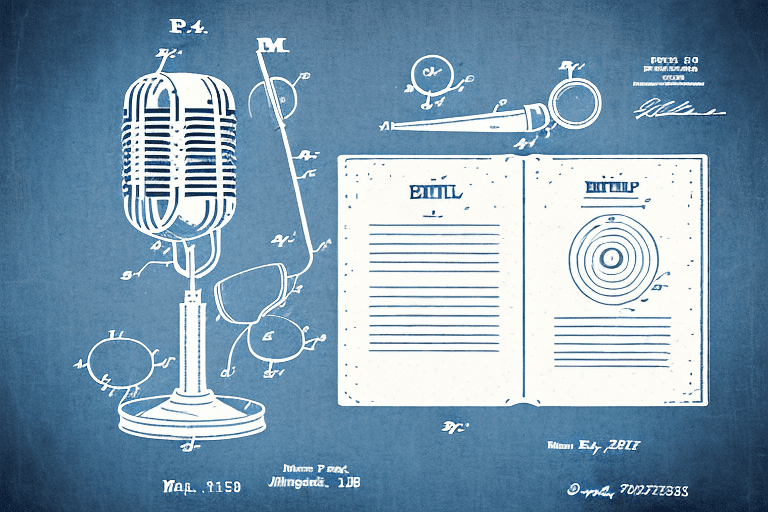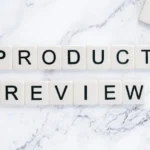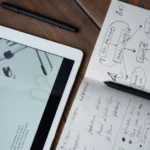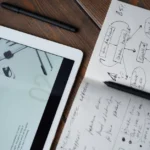Sound recording copyright is a crucial aspect of intellectual property law, particularly in the music industry. In this article, we will delve into the world of sound recording copyright, exploring its basics, its connection to patents, the significance of the Manual of Patent Examining Procedure (MPEP), and the importance of the Patent Bar for sound recording professionals. Additionally, we will analyze case studies of both successful and failed sound recording patent applications.
Understanding the Basics of Sound Recording Copyright
Before delving deeper, it is important to understand the fundamentals of sound recording copyright. Sound recording copyright grants exclusive rights to the owner of a recorded piece of audio, protecting it from unauthorized use, reproduction, distribution, or public performance. This protection encompasses both the underlying musical composition and the specific recording itself.
Sound recording copyright is a complex and multifaceted concept that intertwines legal, artistic, and economic considerations. It is a legal protection that grants the owner the exclusive right to control the reproduction, distribution, and public performance of a recorded audio piece. This includes songs, albums, spoken-word recordings, and other audio content.
One of the key aspects of sound recording copyright is its role in enabling creators to profit from their works. By granting exclusive rights to the owner, it allows them to monetize their recordings through various means, such as licensing, sales, and streaming. This economic incentive is crucial for artists and record labels, as it provides them with the opportunity to recoup their investments and generate income.
Moreover, sound recording copyright plays a vital role in incentivizing artistic expression and fostering creativity in the music industry. By protecting the rights of creators, it encourages musicians, producers, and other audio professionals to invest time, effort, and resources into producing high-quality recordings. This protection ensures that artists can maintain control over their work and have the freedom to explore new artistic directions without fear of exploitation.
Without adequate protection, artists and record labels would face significant challenges in safeguarding their intellectual property from unauthorized use and infringement. The music industry is highly competitive, and unauthorized use of sound recordings can result in financial losses, reputational damage, and the dilution of artistic integrity. Sound recording copyright provides a legal framework to address these challenges and protect the interests of creators.
In conclusion, sound recording copyright is a crucial aspect of the music industry, providing creators with the necessary protection to profit from their works and fostering a climate of artistic expression and creativity. Understanding its basics is essential for anyone involved in the creation, distribution, or performance of recorded audio content.
Delving into the World of Patents
In the realm of sound recording, patents act as another layer of legal protection that complements copyright. Patents protect innovative inventions, including new and useful processes, machines, or compositions of matter. In the context of sound recording, patents can cover technologies and methodologies that enhance the recording process or result in improved audio quality.
Sound recording is a fascinating field that has evolved significantly over the years. From the early days of analog tape recorders to the modern digital era, countless inventors and innovators have contributed to the development of this art form. Patents play a crucial role in fostering innovation in the sound recording industry, providing a framework for protecting and rewarding those who come up with groundbreaking ideas.
The Role of Patents in Sound Recording
Patents play a crucial role in fostering innovation in the sound recording industry. By granting exclusive rights to inventors and innovators, patents encourage the development of new and groundbreaking technologies. Sound recording patents can cover various aspects, such as recording equipment, audio processing software, and novel recording techniques.
When it comes to sound recording equipment, patents can protect the design and functionality of devices such as microphones, mixers, and amplifiers. These inventions can greatly impact the quality and clarity of recorded audio, allowing artists and engineers to capture their creative vision with precision. Additionally, patents can also cover audio processing software, which plays a vital role in enhancing the sound and manipulating it in various ways.
Moreover, patents can extend to cover novel recording techniques that revolutionize the way sound is captured. These techniques may involve innovative microphone placement, advanced signal processing algorithms, or even unconventional approaches to capturing sound in unique environments. By protecting these techniques, patents encourage experimentation and push the boundaries of what is possible in sound recording.
How to Obtain a Patent for Sound Recording
To obtain a patent for a sound recording-related invention, one must follow the established patent application process. This involves conducting a comprehensive prior art search, preparing a detailed patent application, and submitting it to a patent office. The application will undergo examination to assess its novelty, inventiveness, and usefulness before being granted a patent.
The process of obtaining a patent can be complex and time-consuming. It requires a deep understanding of intellectual property law and the ability to articulate the unique features and advantages of the invention. Patent attorneys and agents often play a crucial role in guiding inventors through this process, ensuring that their application meets all the necessary requirements.
Once a patent is granted, the inventor or assignee gains exclusive rights to the invention for a limited period, typically 20 years from the filing date. This exclusivity allows them to commercialize their invention, license it to others, or take legal action against those who infringe upon their rights. Patents not only protect the interests of inventors but also incentivize further innovation by providing a tangible reward for their efforts.
A Closer Look at the Manual of Patent Examining Procedure (MPEP)
The Manual of Patent Examining Procedure (MPEP) serves as the authoritative guide for patent examiners and practitioners involved in the patent application process. It provides detailed instructions, guidelines, and legal precedents that shape the examination and grant of patents.
When diving into the world of patents, it becomes evident that the MPEP plays a crucial role in ensuring a consistent and accurate examination of patent applications. Its comprehensive nature assists patent examiners by providing guidelines on patentability requirements, documentation standards, legal interpretations, and examination procedures. By adhering to the MPEP, patent examiners can effectively evaluate the novelty, non-obviousness, and usefulness of an invention, ensuring that only deserving applicants are granted patent protection.
However, the MPEP’s influence extends beyond the realm of patents. While its primary focus is on patents, its guidelines and legal interpretations indirectly impact other areas, such as sound recording copyright. One might wonder how a manual dedicated to patents could have any relevance to copyright law, specifically in the field of sound recording. Surprisingly, the MPEP does play a role in shaping the boundaries and scope of sound recording inventions that can be granted patent protection.
The Purpose and Function of the MPEP
The primary purpose of the MPEP is to ensure consistent and accurate examination of patent applications. It assists patent examiners by providing guidelines on patentability requirements, documentation standards, legal interpretations, and examination procedures. The MPEP also aids patent practitioners in understanding and navigating the patent process effectively.
Within the MPEP, patent examiners can find detailed instructions on various aspects of the patent examination process. From the initial review of an application to the determination of patentability, the MPEP serves as a comprehensive resource that helps examiners make informed decisions. By following the guidelines outlined in the MPEP, examiners can ensure that their examination is thorough, fair, and in line with legal precedents.
Moreover, the MPEP also provides patent practitioners with valuable insights into the patent process. Patent attorneys and agents can refer to the MPEP to understand the expectations of patent examiners and the requirements for successful patent applications. By having access to this authoritative guide, patent practitioners can effectively navigate the complex maze of patent law and increase their chances of securing patent protection for their clients.
The MPEP’s Influence on Sound Recording Copyright
While the MPEP primarily focuses on patents, its guidelines and legal interpretations indirectly impact the field of sound recording copyright. The MPEP helps establish the criteria for patentability, shaping the boundaries and scope of sound recording inventions that can be granted patent protection. This, in turn, has implications for the interaction between sound recording patents and copyright.
When it comes to sound recording inventions, the MPEP provides guidelines that help determine whether an invention meets the requirements for patentability. These guidelines consider factors such as novelty, non-obviousness, and usefulness. By setting these criteria, the MPEP indirectly affects the scope of patent protection available for sound recording inventions.
Furthermore, the MPEP’s influence on patentability criteria has a ripple effect on copyright law. Sound recordings, being creative works, are eligible for copyright protection. However, the scope of copyright protection afforded to sound recordings can be influenced by the boundaries set by the MPEP. If a sound recording invention fails to meet the patentability requirements outlined in the MPEP, it may impact the level of copyright protection that can be claimed for that particular invention.
Therefore, while the MPEP may not directly address sound recording copyright, its guidelines and legal interpretations indirectly shape the boundaries and scope of sound recording inventions that can be granted patent protection. This, in turn, has implications for the interaction between sound recording patents and copyright, highlighting the interconnectedness of intellectual property laws.
Navigating the Patent Bar
The Patent Bar, also known as the Patent Agent Examination, qualifies individuals to practice patent law before the United States Patent and Trademark Office (USPTO). Passing this examination is crucial for sound recording professionals seeking to represent clients in patent-related matters.
The Importance of the Patent Bar for Sound Recording
The Patent Bar examination is essential for sound recording professionals who wish to assist clients in filing patent applications, respond to office actions, and navigate the complexities of patent law effectively. Having a deep understanding of patent law allows sound recording experts to provide valuable legal guidance and protect their clients’ interests.
Preparing for the Patent Bar Examination
Preparing for the Patent Bar examination requires a comprehensive understanding of patent law, including the intricacies of sound recording patents. Sound recording professionals intending to take the exam should familiarize themselves with relevant patent laws, study patent examination guidelines, and practice solving sample questions to enhance their chances of success.
Case Studies: Sound Recording Copyright and Patents
To gain a practical understanding of sound recording copyright and patents, it is helpful to analyze real-world case studies that exemplify both successful patent applications and failed attempts.
Successful Patent Applications in Sound Recording
In recent years, several notable patent applications in sound recording have garnered success. These patents have covered advancements in audio encoding technologies, novel recording techniques, and innovative audio processing algorithms. The successful grant of these patents has contributed to ongoing innovation and advancement in sound recording.
Lessons from Failed Patent Applications in Sound Recording
While some patent applications succeed, others face challenges and ultimately fail. Failed patent applications in sound recording highlight the importance of careful preparation, comprehensive prior art searches, and robust patent claims. By studying these examples, aspiring patent applicants can learn valuable lessons and avoid common pitfalls in their own patent filings.
Overall, sound recording copyright, patents, the MPEP, and the Patent Bar are integral components of the legal landscape surrounding sound recording. Understanding these aspects is crucial for artists, record labels, inventors, and legal professionals seeking to navigate the complex world of intellectual property in the music industry.






